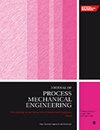可变因素下刮刀和槽边摩擦副的摩擦和磨损实验研究
IF 2.2
4区 工程技术
Q2 ENGINEERING, MECHANICAL
Proceedings of the Institution of Mechanical Engineers, Part E: Journal of Process Mechanical Engineering
Pub Date : 2024-09-04
DOI:10.1177/09544089241272774
引用次数: 0
摘要
为了研究刮板与槽边摩擦副在各种因素作用下的磨损特性和机理,本研究以刮板输送机 SGZ1000/2 × 1200 为原型,设计了相似比为 1:6 的试验台。采用 Plackett-Burman 实验来检验五个关键因素(运行速度、正常载荷、粒度、煤矸石含量和槽边间隙)对槽边磨损的显著影响。结果表明,煤矸石含量的影响最大,而正常载荷的影响相对较小。通过 Box-Behnken 实验设计研究了各因素之间的相互作用。通过得到的二阶回归模型对交互作用进行分析,可以得出结论:运行速度与沟槽侧间隙之间的交互作用以及运行速度与粒度之间的交互作用加剧了沟槽侧磨损。通过单因素实验验证了这些重要因素。为了进一步分析各因素下的磨损变化,选择了各单因素从第二级到第四级的变化,并与其他因素进行比较。运行速度从 0.06 米/秒增加到 0.12 米/秒时,磨损量增加了 102.67%。当粒度从 1.5 mm 增加到 2.5 mm 时,磨损量增加了 95.21%。煤矸石含量的影响最大,含量从 8% 增加到 25%,增加了 205.73%。磨损形态从浅坑和沟槽转向深坑和沟槽,同时磨损量也明显增加。相反,槽侧间隙的磨损量和磨损形态变化最小,当槽侧间隙从 0 mm 增加到 +1 mm 时,磨损量和磨损形态下降了 63.47%。其形态从大量的深坑和沟槽变为较浅和较小的坑和沟槽,表明磨料磨损现象最轻。本文章由计算机程序翻译,如有差异,请以英文原文为准。
Experimental study on the friction and wear of the scraper and groove side friction pair under variable factors
To investigate the wear characteristics and mechanisms of the scraper and groove side friction pair under various factors, this study utilizes the scraper conveyor SGZ1000/2 × 1200 as the prototype and designs a test bench with a similarity ratio of 1:6. The Plackett–Burman experiment is used to examine the significant effects of five key factors (running speed, normal load, particle size, gangue content, and groove side clearance) on the groove side wear. It reveals that gangue content exerts the most significant impact, while the normal load is relatively minor. The interaction between factors is studied through the Box–Behnken experimental design. By analyzing the interaction through the obtained second-order regression model, it can be concluded that the interaction between running speed and groove side clearance, as well as the interaction between running speed and particle size, exacerbates groove side wear. The significant factors are validated through single-factor experiments. To further analyze the variations in wear under each factor, the changes from the second to the fourth level of each single factor are selected and compared with other factors. The running speed increasing from 0.06 m/s to 0.12 m/s results in a 102.67% wear amount increase. A 95.21% increase occurs when the particle size increases from 1.5 mm to 2.5 mm. Gangue content exhibits the most significant impact, where the content increases from 8% to 25%, marking a 205.73% rise. The wear morphology shifts from shallow pits and furrows to deeper ones, accompanied by a noticeable increase in quantity. Conversely, the wear amount and morphology changes least in groove side clearance, when the groove side clearance increases from 0 mm to +1 mm, a decline of 63.47%. The morphology shifts from numerous deep pits and furrows to shallower and smaller ones, indicating the mildest abrasive wear phenomenon.
求助全文
通过发布文献求助,成功后即可免费获取论文全文。
去求助
来源期刊
CiteScore
3.80
自引率
16.70%
发文量
370
审稿时长
6 months
期刊介绍:
The Journal of Process Mechanical Engineering publishes high-quality, peer-reviewed papers covering a broad area of mechanical engineering activities associated with the design and operation of process equipment.

 求助内容:
求助内容: 应助结果提醒方式:
应助结果提醒方式:


